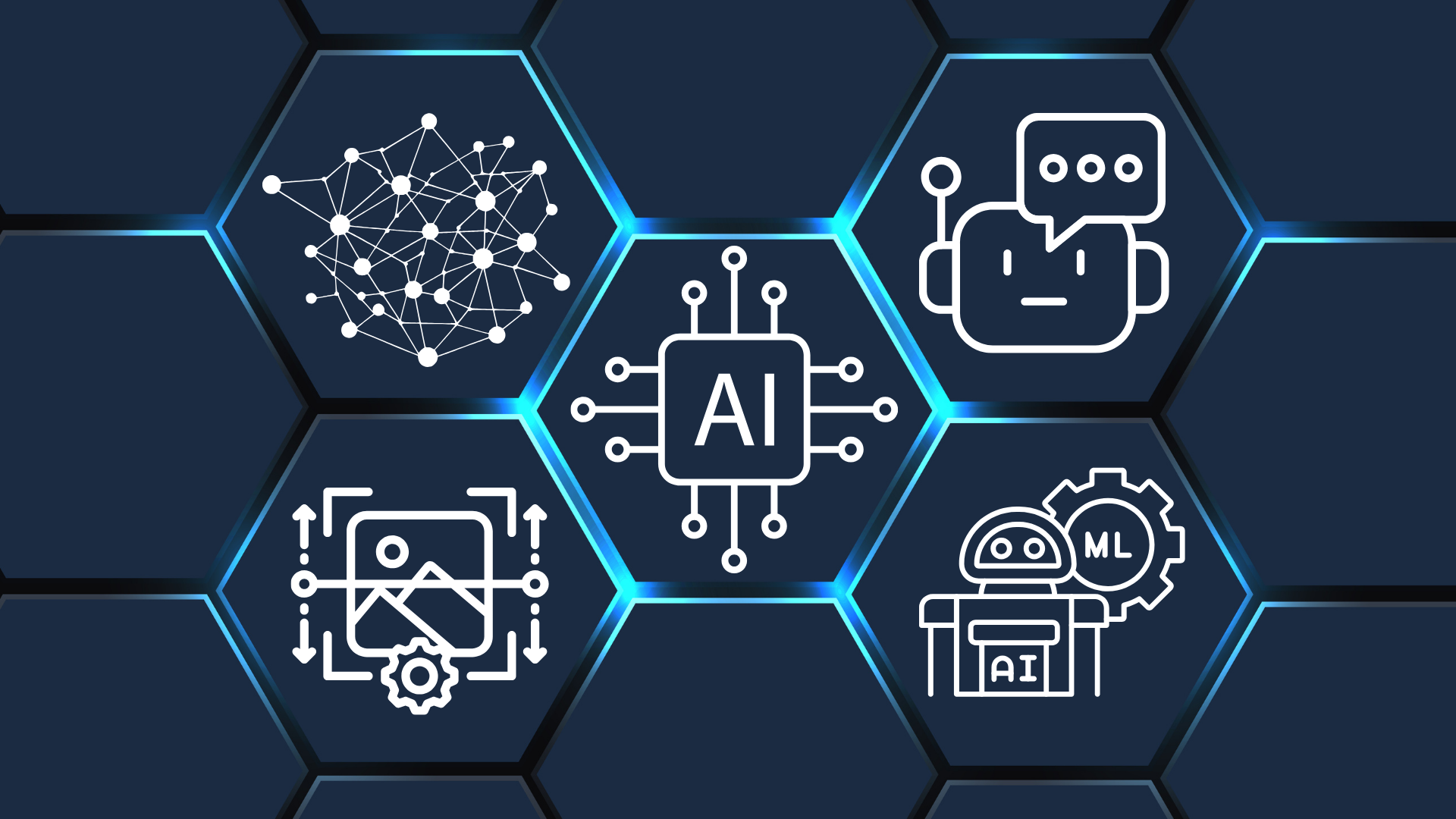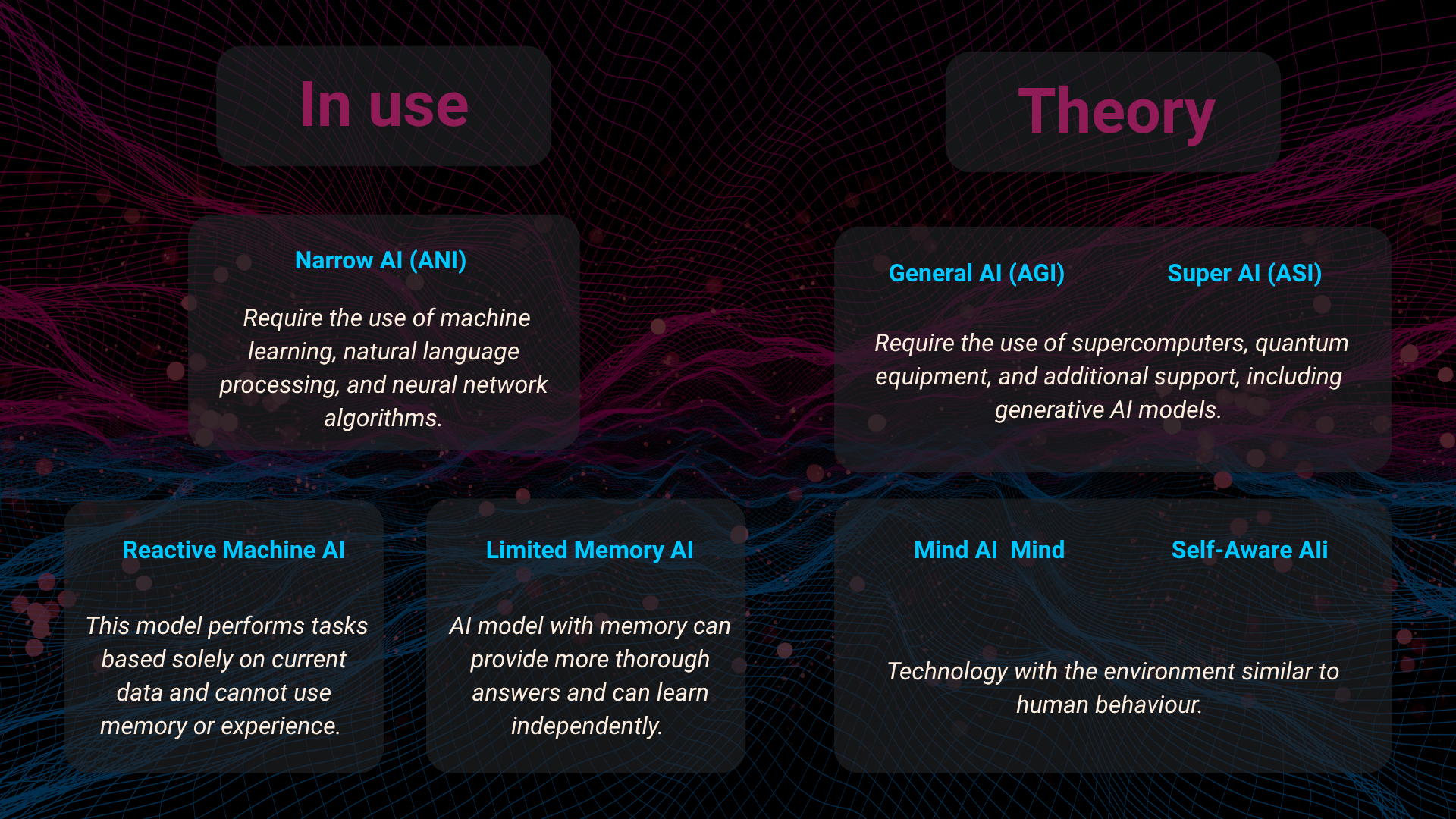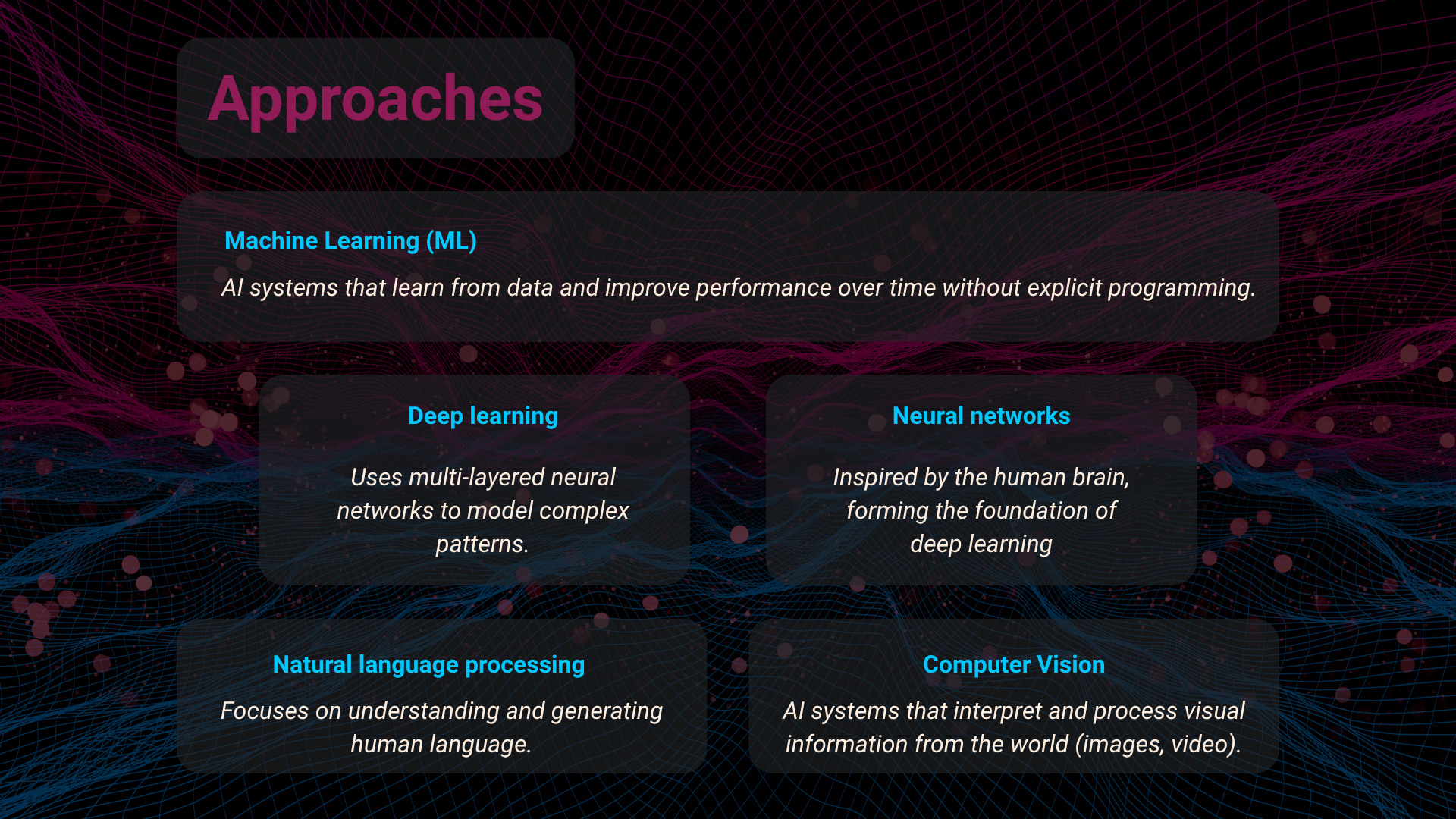Types of Artificial Intelligence


The progress of AI technologies and their implementation in manufacturing and everyday activities is a modern reality. However, the first studies on machine learning began around 1956. It was only 10 years later that the first practical applications began in expert systems for chemical analysis. Mass production began at the end of the 20th century, and since around 2020, the use and development of artificial intelligence has been a hot topic. In this article, we focus on the types of AI, the criteria for their application, and their characteristics.
How can it be useful to be able to distinguish AI by its properties for business? Decisions to implement AI in current software solutions or create new ones are a modern approach for a competitive company. Knowledge about different forms of AI will help customers to more thoroughly formulate requests to technical partners and implement effective solutions in products without risk.
◈ Narrow AI (ANI) – is one that is unable to learn independently outside the defined boundaries of given algorithms. This type of technology is capable of performing tasks in one direction. This is the only solution that actually exists among types of artificial intelligence. Claude AI, ChatGPT, Siri are examples of narrow artificial intelligence. For example, AI designed for autonomous car control cannot write an essay for you or talk to you. These are different types of tasks, and simple AI is not capable of performing them.
It can be implemented through the use of machine learning, natural language processing, and neural network algorithms. As the only actual form of artificial intelligence, this solution is used in various fields such as healthcare, security, fintech, advertising, sales, etc. The problem with this AI is its lack of creativity. The system learns within the framework of already existing solutions. Also, this category of AI is unable to understand context, identify humour, feelings, hidden motives, etc.
Let’s continue to look at the 3 types of AI and move on to its theoretical forms.
◈ General AI (AGI) — is a theoretical form of artificial intelligence that currently has no real-world examples. Strong AI is a concept of a system capable of independent learning, generalising knowledge, and using previous experience to perform new tasks in any field, similar to humans. It is still a technology that simulates the abilities of a universal human. Theoretically, its creation requires super-powerful resources such as supercomputers, quantum equipment, and additional support, including generative AI models.
◈ Super AI (ASI) – Continuing the conversation about forms of AI, we should mention Super AI (ASI). This is a higher form of artificial intelligence that surpasses human capabilities. It is more of a theory from science fiction than from real life.

So, in fact, all artificial intelligence solutions currently implemented in various industries are weak AI, which already has its own internal classification. In this section, we will look at 4 types of AI: functions, advantages, areas of use, and examples.
◈ Reactive Machine AI: Real-Time Decision-Making. This model performs tasks based solely on current data and cannot use memory or experience. It uses only the accurate information available to provide an answer. This model can perform high-quality analysis and grouping of information, but it cannot go beyond algorithms and think outside the box to predict future results based on analysis. Reactive Machine AI cannot accumulate knowledge because it has no memory. At this level of artificial intelligence, the technology shows excellent results in performing routine tasks and instant data processing, and is suitable for automating simple processes. Here are some examples:
Companies can integrate the Real-Time Decision-Making model for use on production lines, in product quality control systems, or in automated packaging. This model is widely used in e-commerce and logistics for inventory management or automatic transaction processing.
◈ Limited Memory AI. As the name suggests, this model already has memory and is therefore superior to the previous one. Limited Memory AI also refers to types of AI that have actually been implemented. Thanks to its short-term memory, the model can provide more thorough answers and can learn independently as a result. The advantages of this model are data accuracy (current and predicted). Therefore, these models are used in smart cars (autopilot), route planning, creating recommendations on streaming platforms, and in voice and face recognition systems. Business is more concentrated at these levels of AI. The technology has a wide range of uses and high adaptability.
Types of artificial intelligence with examples will help companies understand what their product or idea needs and, accordingly, what kind of specialist they need to implement it. We’ve just looked at two more examples that tech companies can already implement and incorporate into your project. However, there are still two theoretical types of AI technology: Mind AI and Self-Aware AI.
◈ AI with Theory of Mind functionality. An unimplemented form of artificial intelligence that models the interaction of technology with the environment similar to human behaviour. For example, such a model could be effectively used to analyse and create creative works, analyse human behaviour and their non-verbal behaviour or reactions, etc.
◈ Self-Aware AI is directly related to ASI and remains at the level of science fiction. A model that understands that it is an AI, but can act consciously and independently, can be inspired, distinguish emotions, and have its own mood. If successfully implemented, such an AI will be able to effectively analyse emotions, recognise voices, human mood, analyse this data, and react accordingly.
In this section, we will look at the 5 main approaches of artificial intelligence that are integrated into modern software. There are industries where the application of AI is still minimal or at an early stage (for example, rare narrow crafts where manual work is important, some cultural and creative areas). In some areas, AI is still being used only experimentally due to ethical, legal, or technical limitations. Nevertheless, the types of artificial intelligence we are going to consider have indeed found their application in various industries: agriculture, entertainment and media, economics, banking, logistics, education, science and research, medicine, industry, etc.

◈ Machine Learning (ML) is not a type of AI as such. It is a method or approach to implementing this technology. Its main task is automatic training of systems based on data without direct programming of rules Automatic training of systems based on data without direct programming of rules. Developers use Deep Learning and Data Preprocessing with the support of such frameworks as TensorFlow and PyTorch to implement machine learning functions. The components of learning are Supervised Learning, Unsupervised Learning, and Semi-supervised Learning algorithms.
The application of machine learning is also unlimited: today, this method is used in scientific fields, medicine, cybersecurity, and in such familiar platform recommendations.
Like any complex technology, ML has challenges associated with high requirements. Therefore, businesses should understand that the technical implementation will be financially costly, and the level of specialists should meet this demand.
◈ A subcategory of ML is deep learning, which is most often used to implement Limited Memory AI. At these levels of AI, DL technologies are used to simulate human conversation or automate machines or processes. For example, to implement a software product with a chatbot, virtual assistant, or car software, you need to hire a company and specialists specialised in DL and ML technologies.
◈ Neural networks are a component of modern deep learning that mimics the human brain to process and analyse data. Their main functions include pattern recognition, classification, forecasting, and data generation. The technology can only be implemented by highly skilled developers with experience in mathematical modelling, programming in Python or R, and using deep learning frameworks. Practical skills in big data analytics, setting up computing environments (GPU, cloud platforms), and experience with different types of artificial intelligence will be an advantage when looking for a technology partner. Well-known applications of neural networks are in speech and image recognition, natural language processing (NLP), autonomous transport, medical diagnostics and recommender systems.
◈ Natural language processing (NLP) is another subset of different forms of AI. It focuses on the interaction between computers and human language. NLP allows machines to understand, interpret, analyse, and generate text and speech in a way that is natural to humans. Key NLP technologies include tokenisation, morphological and syntactic analysis, semantic recognition, word vectorisation and transformational architectures. Key applications include automatic translation, voice assistants, etc.
◈ Different types of AI use computer vision. It is a branch of artificial intelligence that enables machines to analyse and interpret images and videos similar to human vision. The main functions include object recognition, motion tracking, image segmentation, face identification, and automatic anomaly detection.
We can confidently say that AI has a promising future, and researchers continue to look for ways to expand and enhance it. Businesses and enterprises are no less interested in implementing this technology. However, the development of AI is a hot topic of debate in terms of morality and ethics, which are also addressed by technical experts. Particular attention is paid to the transparency of algorithms, avoidance of model bias, protection of personal data, and safe implementation of autonomous systems. Therefore, the further development of different types of AI requires not only technological improvements but also the creation of a regulatory framework and ethical standards that will ensure its responsible and safe use in various spheres of life.
PNN Soft has experience in working with big data, leading technologies and advanced languages. We specialise in creating custom solutions for highly regulated industries, as well as for large and medium-sized businesses. Our team implements modern artificial intelligence, machine learning, and analytics tools to optimise business processes, increase efficiency, and improve competitiveness.
We have reviewed the types of artificial intelligence with examples to make your path to getting to know and integrating the technology into your product clearer and easier. You can leave your request for AI-enabled software development in the form below. We will analyse your request and get back to you.